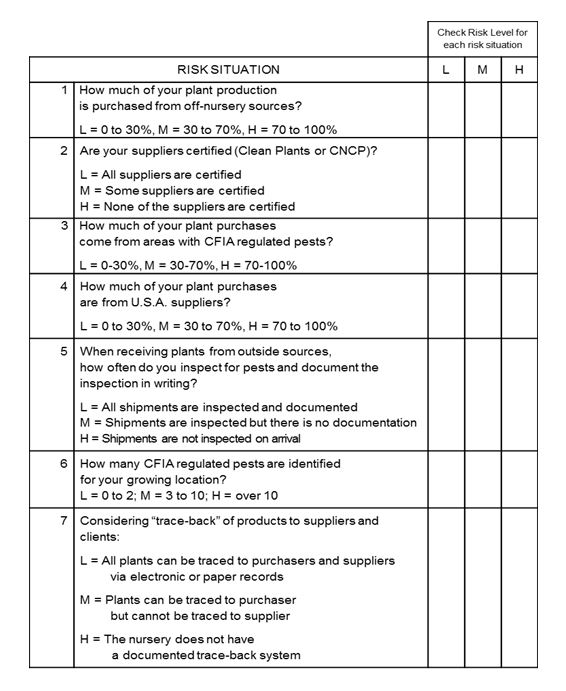Nursery Sector Biosecurity Guide
Appendix 1: Example of a Risk Assessment Tool
Example of a Risk Assessment ToolFootnote 17
The following questions examine the potential to introduce or spread a new serious pest. Consider every risk situation and identify whether the risk for your operation would be low (L), medium (M) or high (H). Answers provided are suggestions only.

Description for photo - Example of a Risk Assessment Tool
A table with three main columns. From left to right, the first column does not have a heading and the rows below it are filled with numbers to denote each risk situation listed in the second column. The heading of the second column says: Risk Situation. The heading of the last column says: Check risk level for each risk situation. The last column is divided into three sub-columns. From left to right the headings are L, M, H. Under the Risk Situation heading there are seven rows that each contain text stating a risk situation. The first risk situation states: How much of your plant production is purchased from off-nursery sources? L = 0% to 30%, M = 30 to 70%, H = 70 to 100%. The second risk situation states: Are your suppliers certified (Clean Plants or CNCP)? L = All suppliers are certified, M = Some suppliers are certified, H = None of the suppliers are certified. The third risk situation states: How much of your plant purchases come from areas with CFIA regulated pests? L = 30%, M = 30 – 70%, H = 70 – 100%. The fourth risk situation states: How much of your plant purchases are from U.S.A. suppliers? L = 0 to 30%, M = 30 to 70%, H = 70 to 100%. The fifth risk situation states: When receiving plants from outside sources, how often do you inspect for pests and document the inspection in writing? L = All shipments are inspected and documented, M = Shipments are inspected but there is no documentation, H = Shipments are not inspected on arrival. The sixth risk situation states: How many CFIA regulated Pests are identified for your growing location? L = 0 to 2, M = 3 to 10, H = over 10. The seventh risk situation states: Considering "trace-back" of products to suppliers and clients: L = All plants can be traced to purchasers and suppliers via electronic or paper records, M = Plants can be traced to purchaser but cannot be traced to supplier, H = The nursery does not have a documented trace-back system.
- Date modified: